Answered step by step
Verified Expert Solution
Question
1 Approved Answer
3. Compute the cost assigned to ending inventory using ( a ) FIFO, ( b ) LIFO, ( c ) weighted average, and ( d
3. Compute the cost assigned to ending inventory using (a) FIFO, (b) LIFO, (c) weighted average, and (d) specific identification. For specific identification, units sold consist of 620 units from beginning inventory, 280 from the February 10 purchase, 100 from the March 13 purchase, 120 from the August 21 purchase, and 185 from the September 5 purchase.
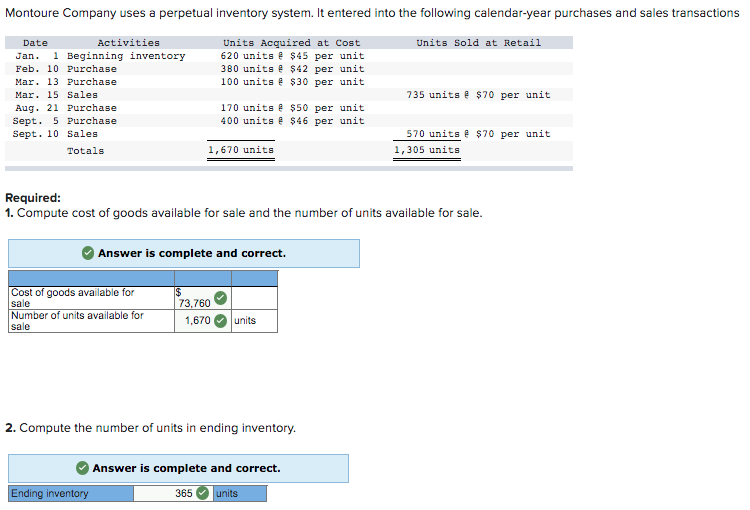
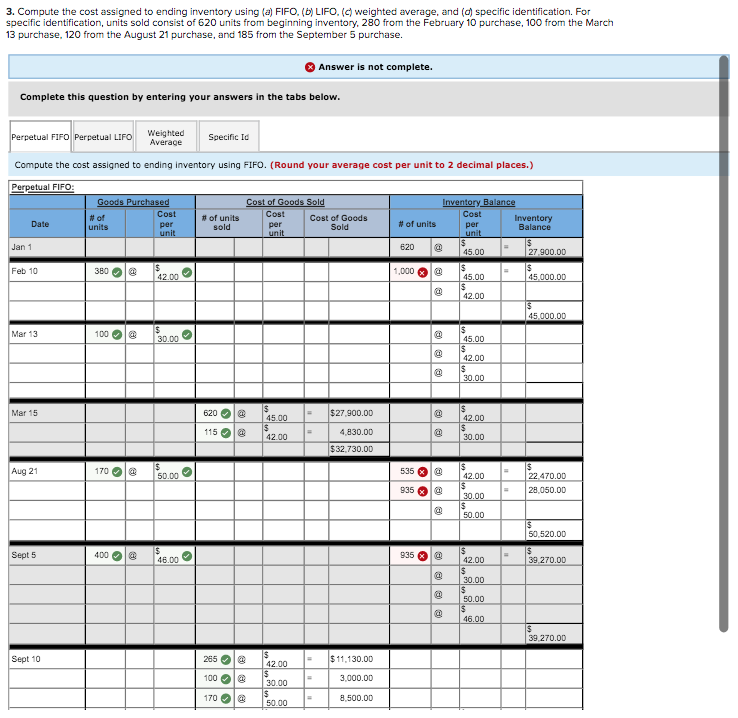
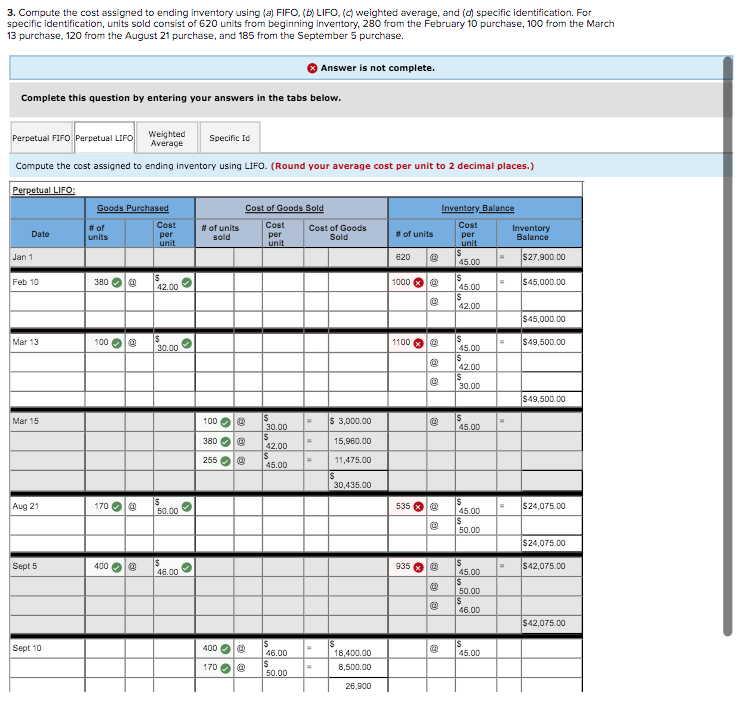
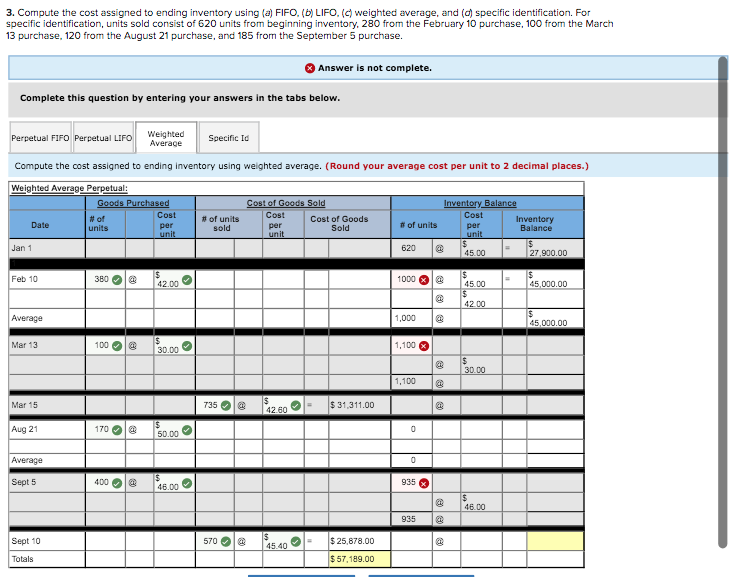
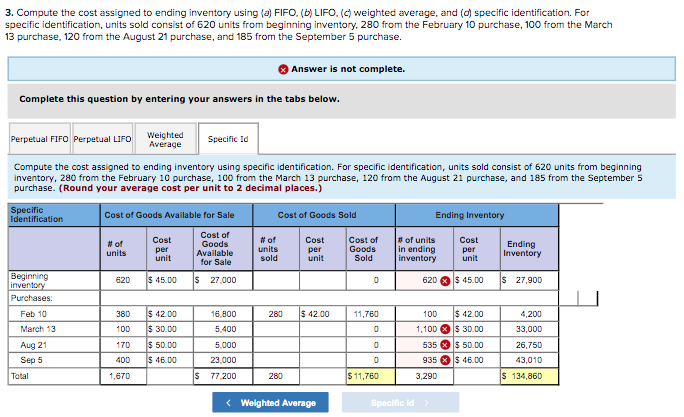
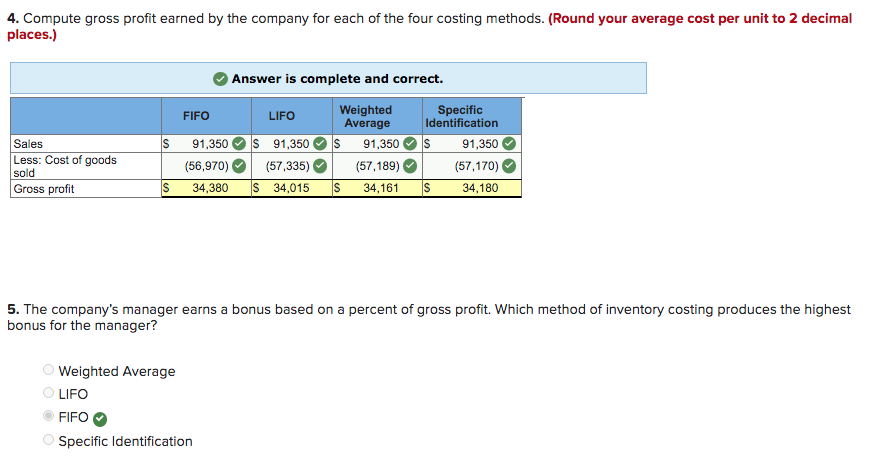
Montoure Company uses a perpetual inventory system. It entered into the following calendar-year purchases and sales transactions Units Sold at Retail Units Acquired at Cost 620 units & $45 per unit 380 units & $42 per unit 100 units & $30 per unit Date Activities Jan. 1 Beginning inventory Feb. 10 Purchase Mar. 13 Purchase Mar. 15 Sales Aug. 21 Purchase Sept. 5 Purchase Sept. 10 Sales Totals 735 units $70 per unit 170 units & $50 per unit 400 units & $46 per unit 570 units $70 per unit 1,305 units 1,670 units Required: 1. Compute cost of goods available for sale and the number of units available for sale. Answer is complete and correct. Cost of goods available for Number of units available for sale 73.760 1,670 units sale 2. Compute the number of units in ending inventory. Answer is complete and correct. Ending inventory 365 units 3. Compute the cost assigned to ending inventory using (a) FIFO.() LIFO. (weighted average, and (d) specific identification. For specific identification, units sold consist of 620 units from beginning inventory, 280 from the February 10 purchase, 100 from the March 13 purchase, 120 from the August 21 purchase, and 185 from the September 5 purchase. Answer is not complete. Complete this question by entering your answers in the tabs below. Perpetual FIFO Perpetual LIFO Weighted Average Specific Id Compute the cost assigned to ending inventory using FIFO. (Round your average cost per unit to 2 decimal places.) Perpetual FIFO: Goods Purchased # of Cost units per unit Cost of Goods Sold Cost Cost of Goods per Sold unit # of units sold Date # of units Inventory Balance Cost Inventory per Balance unit $ $ 45.00 27,900.00 s 45.00 45,000.00 Jan 1 620 Feb 10 $ 42.00 1,000 42.00 IS 45,000.00 Mar 13 100 $ 30.00 BB $ 45.00 IS 42.00 IS 30.00 Mar 15 620 $27.900.00 $ 45.00 $ 42.00 IS 42.00 $ 30.00 115 80 4.830.00 $32.730.00 Aug 21 170 60 $ 50.00 . 535 $ 42.00 IS 30.00 $ 50.00 IS 22.470.00 28.050.00 935 $ 50,520.00 Sept 5 400 $ 46.00 935 X $ 39.270.00 IS 42.00 S 30.00 IS 50.00 $ 46.00 $ 39,270.00 Sept 10 265 $11.130.00 00 100 $ 42.00 $ 30.00 IS 50.00 3,000.00 170 8,500.00 3. Compute the cost assigned to ending inventory using (a) FIFO. () LIFO. (c) weighted average, and (d) specific identification. For specific identification, units sold consist of 620 units from beginning inventory, 280 from the February 10 purchase, 100 from the March 13 purchase, 120 from the August 21 purchase, and 185 from the September 5 purchase. Answer is not complete. Complete this question by entering your answers in the tabs below. Perpetual FIFO Perpetual LIFO Weighted Average Specific Id Compute the cost assigned to ending inventory using LIFO. (Round your average cost per unit to 2 decimal places.) Perpetual LIFO Goods Purchased #of Cost units per unit Cost of Goods Sold Cost Cost of Goods per Sold unil # of units sold Date # of units Jan 1 620 Inventory Balance Cost Inventory per Balance unit IS 45.00 $27,900.00 s 45.00 $45,000.00 IS 42.00 $45,000.00 Feb 10 380 > s 42.00 1000 16 Mar 13 100 1100 3 $49,500.00 S 45.00 S 42.00 IS 30.00 $49,500.00 Mar 15 100 $ 3,000.00 @ s 30.00 s 42.00 s 45.00 380 15,950.00 255 > 45.00 11,475.00 S 30,435.00 Aug 21 170 @ s 50.00 535 3 2 IS 45.00 $24,075.00 50.00 $24.075.00 Sept 5 400 IS > 935 $42.075.00 46.00 IS 45.00 IS 50.00 S 46.00 08 $42,075.00 Sept 10 400 @ IS 18,400.00 8,500.00 S 46.00 Is 50.00 IS 45.00 170 26,900 3. Compute the cost assigned to ending inventory using (a) FIFO. (D) LIFO. (weighted average, and (d) specific identification. For specific identification, units sold consist of 620 units from beginning inventory. 280 from the February 10 purchase, 100 from the March 13 purchase, 120 from the August 21 purchase, and 185 from the September 5 purchase. Answer is not complete. Complete this question by entering your answers in the tabs below. Perpetual FIFO Perpetual LIFO Weighted Average Specific Id Compute the cost assigned to ending inventory using weighted average. (Round your average cost per unit to 2 decimal places.) Weighted Average Perpetual: Goods Purchased Cost # of Date units per unit Jan 1 # of units sold Cost of Goods Sold Cost Cost of Goods per Sold unit # of units Inventory Balance Cost Inventory per Balance unit $ $ 45.00 27,900.00 620 Feb 10 . 42.00 . 1000 @ $ 45.00 $ 42.00 $ 45,000.00 Average 1,000 $ 45,000.00 Mar 13 100 $ 30.00 . 1.100 3 $ 30.00 1,100 Mar 15 735 $ 42.60 $ 31,311.00 Aug 21 170 $ 50.00 0 Average 0 Sept 5 400 $ 48.00 . 935 @ 18.00 935 Sept 10 570 $ 45.40 - $ 25,878.00 $57,189.00 Totals 3. Compute the cost assigned to ending inventory using (a) FIFO. () LIFO. (c) weighted average, and (d) specific identification. For specific identification, units sold consist of 620 units from beginning inventory, 280 from the February 10 purchase, 100 from the March 13 purchase, 120 from the August 21 purchase, and 185 from the September 5 purchase. Answer is not complete. Complete this question by entering your answers in the tabs below. Perpetual FIFO Perpetual LIFO Weighted Average Specific Id Compute the cost assigned to ending inventory using specific identification. For specific identification, units sold consist of 620 units from beginning inventory, 280 from the February 10 purchase, 100 from the March 13 purchase, 120 from the August 21 purchase, and 185 from the September 5 purchase. (Round your average cost per unit to 2 decimal places.) Specific Identification Cost of Goods Available for Sale Cost of Goods Sold Ending Inventory # of units Cost per unit Cost of Goods Available for Sale # of units sold Cost per unit Cost of Goods Sold # of units in ending inventory Cost per unit Ending Inventory 620 $ 45.00 IS 27.000 0 620 $ 45.00 $ 27,900 Beginning inventory Purchases: 380 280 $ 42.00 11,760 16.800 5.400 100 0 Feb 10 March 13 Aug 21 Sep 5 Total $ 42.00 $ 30.00 $ 50.00 $ 46.00 100 $ 42.00 1,100 $ 30.00 535 $ 50.00 935 X $ 46.00 170 5.000 0 4,200 33,000 26,750 43,010 $ 134,860 400 23.000 0 1.670 s 77 200 280 $ 11,760 3,290
Step by Step Solution
There are 3 Steps involved in it
Step: 1

Get Instant Access to Expert-Tailored Solutions
See step-by-step solutions with expert insights and AI powered tools for academic success
Step: 2

Step: 3

Ace Your Homework with AI
Get the answers you need in no time with our AI-driven, step-by-step assistance
Get Started


